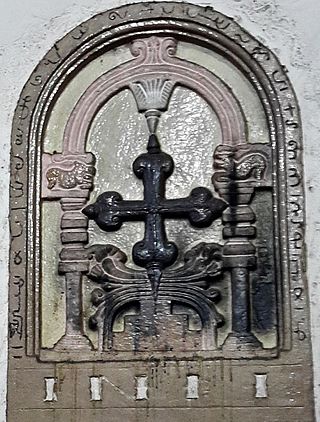
The Saint Thomas Christians, also called Syrian Christians of India, Marthoma Suriyani Nasrani, Malankara Nasrani, or Nasrani Mappila, are an ethno-religious community of Indian Christians in the state of Kerala, who, for the most part, employ the Eastern and Western liturgical rites of Syriac Christianity. They trace their origins to the evangelistic activity of Thomas the Apostle in the 1st century. The Saint Thomas Christians had been historically a part of the hierarchy of the Church of the East but are now divided into several different Eastern Catholic, Oriental Orthodox, Protestant, and independent bodies, each with their own liturgies and traditions. They are Malayalis and their mother tongue is Malayalam, which is a Dravidian language. Nasrani or Nazarene is a Syriac term for Christians, who were among the first converts to Christianity in the Near East.

The Syro-Malankara Catholic Church, also known as the Malankara Syrian Catholic Church, is an Eastern Catholic sui iuris particular church in full communion with the worldwide Catholic Church possessing self-governance under the Code of Canons of the Eastern Churches. It is one of the major archiepiscopal churches of the Catholic Church. It is headed by Major Archbishop Baselios Cardinal Cleemis Catholicos of the Major Archdiocese of Trivandrum based in Kerala, India. With more than 1096 parishes, its one of India's biggest church evangelical establishments.

The Syro-Malabar Church, also known as the Syro-Malabar Catholic Church, is an Eastern Catholic Church based in Kerala, India. It is a sui iuris (autonomous) particular church in full communion with the Holy See and the worldwide Catholic Church, with self-governance under the Code of Canons of the Eastern Churches (CCEO). The major archbishop presides over the entire church. The incumbent Major Archbishop is Raphael Thattil, serving since January 2024. The Syro-Malabar Synod of Bishops canonically convoked and presided over by the major archbishop constitutes the supreme authority of the church. The Major Archiepiscopal Curia of the church is based in Kakkanad, Kochi. Syro-Malabar is a prefix reflecting the church's use of the East Syriac Rite liturgy and origins in Malabar. The name has been in usage in official Vatican documents since the nineteenth century.
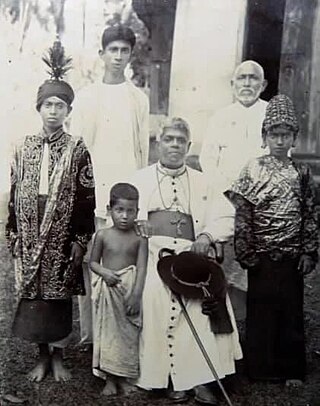
The K'nānāya, also known as the Southists or Tekkumbhagar, are an endogamous ethnic group found among the Saint Thomas Christian community of Kerala, India. They are differentiated from another part of the community, known in this context as the Northists (Vaddakkumbhagar). There are about 300,000 Knanaya in India and elsewhere.

Margamkali is an ancient Indian round dance of the St. Thomas Christians community- based in Kerala state, mainly practiced by the endogamous sub-sect known as the Knanaya or Southist Christians. The dance retells the life and missionary work of Thomas the Apostle, based on the 3rd-century apocryphal Acts of Thomas.
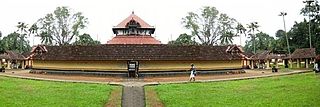
Kaduthuruthy is a town in Kottayam District in the state of Kerala, India.
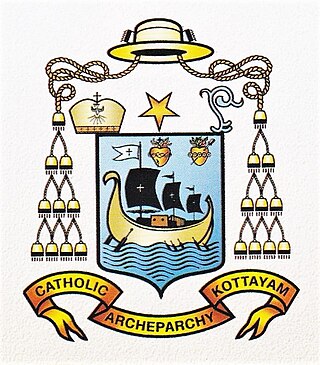
The Archeparchy of Kottayam is a Syro-Malabar Church metropolitan archeparchy of the Catholic Church in India. The archeparchy is exclusively for Knanaya faithful who are the descendants of Syriac Judeo-Christians who migrated from South Mesopotamia to Kodungallur (Muziris) in South India in 4th century A.D.
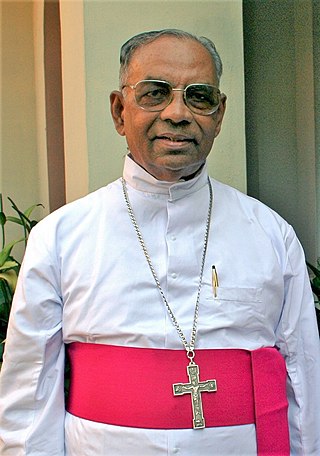
Kuriakose Kunnassery was a Syro-Malabar Catholic hierarch. He was the fourth bishop of the Syro-Malabar Catholic Archeparchy of Kottayam and the first Archbishop of the Archdiocese of Kottayam. He served as priest in the Diocese of Kottayam for 13 years from December 21, 1955 to February 24, 1968. Then he was bishop for 49 years from February 24, 1968 to June 14, 2017. Kunnacherry was head of the Diocese of Kottayam for 31 years from May 5, 1974 to December 19, 2005. He was elevated as Archbishop on May 19, 2005.

This article lists the various old and ancient churches that exist among the Saint Thomas Christians in Kerala.

Thomas of Cana was a Syrian Christian merchant magnate who arrived to the Chera Dynasties capital city of Kodungallur between 345 A.D. and 811 A.D. Thoma brought with him Jewish-Christian families and clergymen from Persian Mesopotamia.

Mar Thoma Sleeva (Saint Thomas Cross) are ancient crosses associated with the community of Indian subcontinent, who trace their origins to the evangelism of Thomas the Apostle in the 1st century AD. The Saint Thomas Christians, which is one of the oldest Christian communities of the world, survive in the Malabar region in state of Kerala, India and have a diaspora in other parts of the Indian subcontinent. Saint Thomas Christian crosses are known as Mar Thoma Sleeva (Saint Thomas cross), Indian cross, or Persian Cross in English, as well as Nasrani Sthambam in Malabarese.

The Malankara Church, also known as Puthenkur, is the historic unified body of West Syriac Saint Thomas Christian denominations which claim ultimate origins from the missions of Thomas the Apostle. This community, under the leadership of Thoma I, opposed the Padroado Jesuits as well as the Propaganda Carmelites of the Latin Church, following the historical Coonan Cross Oath of 1653. The Malankara Church's divisions and branchings have resulted in present-day Churches that include the Jacobite Syrian Christian Church, the Malankara Orthodox Syrian Church, the Malankara Mar Thoma Syrian Church, the Malabar Independent Syrian Church, the Syro-Malankara Catholic Church, the Saint Thomas Anglicans of the Church of South India and the St. Thomas Evangelical Church of India.

Christianity is the third-largest practiced religion in Kerala, accounting for 18% of the population according to the 2001 Indian census. According to traditional accounts, Thomas the Apostle sailed to the Malabar region in 52 AD and introduced Christianity to the area. Although a minority, the Christian population of Kerala is proportionally much larger than that of India as a whole. A significant portion of the Indian Christian population resides in the state.

The Saint Thomas Christian denominations are Christian denominations from Kerala, India, which traditionally trace their ultimate origins to the evangelistic activity of Thomas the Apostle in the 1st century. They are also known as "Nasranis" as well. The Syriac term "Nasrani" is still used by St. Thomas Christians in Kerala. It is part of the Eastern Christianity institution.
Tharakan. The title of Tharakan is an honorific hereditary title which was bestowed upon a few prominent Saint Thomas Christian families in the former Kingdoms of Travancore and Cochin, currently the State of Kerala in India.
Reflecting the religious constitution of the population, a large number of Hindu temples and Christian churches dot the townscape of Kottayam district. Some of them are the Thirunakkara Mahadeva temple, Kumaranalloor Devi temple, Thiruvarrpu Sri Krishna Temple, Thaliyil Mahadeva Temple, Pallippurathukavu Bhagavathi Temple, Elia Cathedral, Kottayam Valiya Pally, Manarcad Cathedral, Cheriya Palli, CSI Holy Trinity cathedral, Puthuppally St. George Church and Thazhathangadi Juma Masjid. All the temples of Kottayam were also built under royal patronage of Hinduism during the 2nd millennium.
Malankara Syriac Knanaya Community are part of the larger Knanaya community who are descendants of an endogamous ethnic migrant group of Syriac-Jewish Christians who arrived and settled in Kerala in the 4th or 8th century.

Kadavil Chandy Kathanar, also known as Alexander the Indian was a Kathanar (priest) and a celebrated scholar, orator, hymnographer and syriacist from the Saint Thomas Christian community in India. He was a prominent face of the Saint Thomas Christians and lead their Catholic faction during a turbulent period of divisions in the community after the Coonan Cross Oath of 1653. He was from Kaduthuruthy, Kottayam in Kerala state of India. He often reacted vehemently against the colonial Padroado latin subjugation over his community and resisted their ecclesiastical and cultural dominance. He was widely reputed for his knowledge in Syriac language and literature, and was often praised, both among his own community and the European missionaries who wrote about him in their letters addressed to the Portuguese monarch and to the Pope. His acrostic poems propagated even among West Asia's Syriac-speaking communities. Although he stood against the Latin colonialists, he commanded respect from the Portuguese and the local Hindu kings alike.











